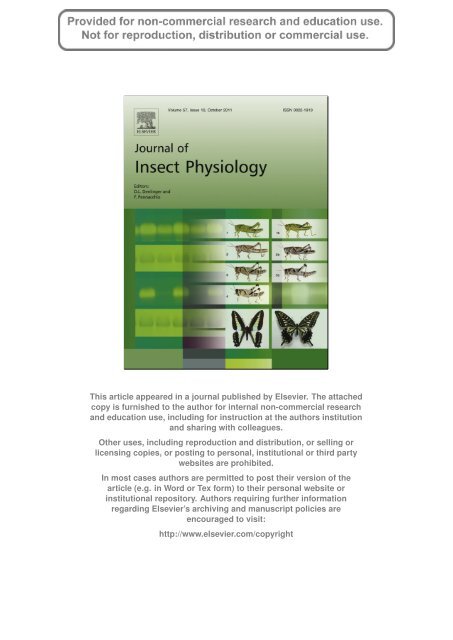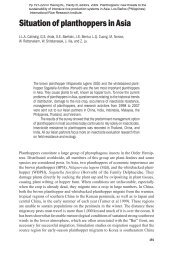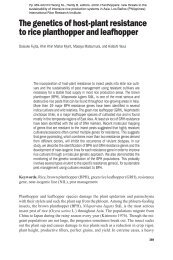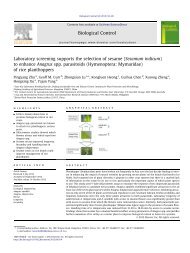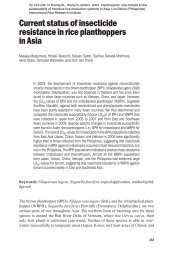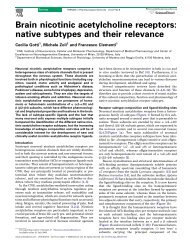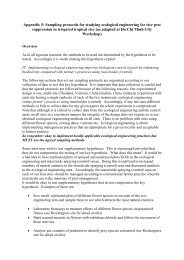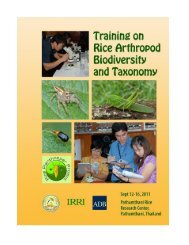Chen, Yolanda et al. 2011. Planthopper âadaptationâ - Ricehoppers
Chen, Yolanda et al. 2011. Planthopper âadaptationâ - Ricehoppers
Chen, Yolanda et al. 2011. Planthopper âadaptationâ - Ricehoppers
Create successful ePaper yourself
Turn your PDF publications into a flip-book with our unique Google optimized e-Paper software.
This article appeared in a journ<strong>al</strong> published by Elsevier. The attached<br />
copy is furnished to the author for intern<strong>al</strong> non-commerci<strong>al</strong> research<br />
and education use, including for instruction at the authors institution<br />
and sharing with colleagues.<br />
Other uses, including reproduction and distribution, or selling or<br />
licensing copies, or posting to person<strong>al</strong>, institution<strong>al</strong> or third party<br />
websites are prohibited.<br />
In most cases authors are permitted to post their version of the<br />
article (e.g. in Word or Tex form) to their person<strong>al</strong> website or<br />
institution<strong>al</strong> repository. Authors requiring further information<br />
regarding Elsevier’s archiving and manuscript policies are<br />
encouraged to visit:<br />
http://www.elsevier.com/copyright
Author's person<strong>al</strong> copy<br />
Journ<strong>al</strong> of Insect Physiology 57 (2011) 1375–1384<br />
Contents lists available at ScienceDirect<br />
Journ<strong>al</strong> of Insect Physiology<br />
journ<strong>al</strong> homepage: www.elsevier.com/locate/jinsphys<br />
<strong>Planthopper</strong> ‘‘adaptation’’ to resistant rice vari<strong>et</strong>ies: Changes in amino acid<br />
composition over time<br />
<strong>Yolanda</strong> H. <strong>Chen</strong> a,c,⇑ , Carmencita C. Bern<strong>al</strong> a , Jing Tan b , Finbarr G. Horgan a , Melissa A. Fitzger<strong>al</strong>d b<br />
a Division of Crop and Environment<strong>al</strong> Sciences, Internation<strong>al</strong> Rice Research Institute, Los Baños, Laguna, Philippines<br />
b Grain Qu<strong>al</strong>ity, Nutrition, and Postharvest Center, Internation<strong>al</strong> Rice Research Institute, Los Baños, Laguna, Philippines<br />
c Department of Plant and Soil Sciences, University of Vermont, 63 Carrigan Drive, Burlington, VT, USA<br />
article<br />
info<br />
abstract<br />
Article history:<br />
Received 10 February 2011<br />
Received in revised form 24 June 2011<br />
Accepted 5 July 2011<br />
Available online 18 July 2011<br />
Keywords:<br />
Amino acid<br />
M<strong>et</strong>abolism<br />
Endosymbionts<br />
Host plant resistance<br />
Adaptation<br />
Virulence<br />
The brown planthopper, Nilaparvata lugens, shows considerable geographic and tempor<strong>al</strong> variability in its<br />
response to vari<strong>et</strong>ies of cultivated rice. N. lugens has repeatedly ‘‘adapted’’ to resistant rice vari<strong>et</strong>ies; however,<br />
the physiologic<strong>al</strong> changes underlying planthopper adaptation are poorly understood. Endosymbionts<br />
within planthoppers, such as yeast-like endosymbionts (YLS) could play a role as they<br />
produce essenti<strong>al</strong> amino acids for planthoppers. We used a full factori<strong>al</strong> study to d<strong>et</strong>ermine how nat<strong>al</strong><br />
rice vari<strong>et</strong>y, exposed rice vari<strong>et</strong>y, YLS presence, and the number of reared generations affected nymph<strong>al</strong><br />
development, planthopper tot<strong>al</strong> nitrogen content, and planthopper hydrolyzed amino acid profiles. Nymph<strong>al</strong><br />
development was strongly influenced by a four-way interaction b<strong>et</strong>ween the exposed rice vari<strong>et</strong>y,<br />
nat<strong>al</strong> rice vari<strong>et</strong>y, number of reared generations, and YLS presence. While symbiosis improved nymph<strong>al</strong><br />
performance in the 8th generation, it appeared to be a drain on nymphs in the 11th generation, when the<br />
aposymbiotic nymphs actu<strong>al</strong>ly showed higher performance than the symbiotic nymphs. This suggests<br />
that the symbiotic relationship may be acting benefici<strong>al</strong>ly in one generation while acting as a drain during<br />
another generation. Aposymbiotic planthoppers reared for 11 generations had a higher proportion<strong>al</strong><br />
concentration of rare amino acids than those reared for 8 generations, indicating that the planthopper<br />
itself appears to improve its ability to acquire rare amino acids. Therefore, the change in amino acid composition<br />
of planthoppers suggests an underlying change in protein expression or amino acid m<strong>et</strong>abolism<br />
over time.<br />
Ó 2011 Elsevier Ltd. All rights reserved.<br />
1. Introduction<br />
The brown planthopper, Nilaparvata lugens Stål (Hemiptera:<br />
Delphacidae), shows considerable geographic and tempor<strong>al</strong> variability<br />
in its response to cultivated rice vari<strong>et</strong>ies (Heinrichs <strong>et</strong> <strong>al</strong>.,<br />
1985; Pathak and Khush, 1979; Pathak and Heinrichs, 1982). As a<br />
product of the Green Revolution (Kenmore <strong>et</strong> <strong>al</strong>., 1984), N. lugens<br />
outbreaks have threatened rice production and food security (Cohen<br />
<strong>et</strong> <strong>al</strong>., 1997; Dyck and Thomas, 1979). Although there has been<br />
significant investment in breeding for rice resistance to the brown<br />
planthopper in Asia (Cha <strong>et</strong> <strong>al</strong>., 2008; Cohen <strong>et</strong> <strong>al</strong>., 1997; Heinrichs<br />
<strong>et</strong> <strong>al</strong>., 1985; Jairin <strong>et</strong> <strong>al</strong>., 2007; Jena <strong>et</strong> <strong>al</strong>., 2006; Lu <strong>et</strong> <strong>al</strong>., 2007; Park<br />
<strong>et</strong> <strong>al</strong>., 2007; Su <strong>et</strong> <strong>al</strong>., 2006; Sun <strong>et</strong> <strong>al</strong>., 2007), the emphasis on gene<br />
discovery for planthopper resistance has severe shortcomings. N.<br />
lugens has repeatedly shown the ability to rapidly ‘‘adapt’’ to resistant<br />
rice vari<strong>et</strong>ies after sever<strong>al</strong> generations of continuous rearing in<br />
⇑ Corresponding author at: Department of Plant and Soil Sciences, University of<br />
Vermont, 63 Carrigan Drive, Burlington, VT, USA. Tel.: +1 802 656 2627; fax: +1 802<br />
656 4656.<br />
E-mail address: <strong>Yolanda</strong>.<strong>Chen</strong>@uvm.edu (Y.H. <strong>Chen</strong>).<br />
the field and laboratory (Claridge and den Hollander, 1983; Claridge<br />
<strong>et</strong> <strong>al</strong>., 1982, 1984; G<strong>al</strong>lagher <strong>et</strong> <strong>al</strong>., 1994). We use the term<br />
‘‘adaptation’’ to describe how planthoppers increase their performance<br />
on a single rice vari<strong>et</strong>y over sever<strong>al</strong> generations. Given that<br />
planthopper ‘‘adaptation’’ occurs over months, it appears to occur<br />
too rapidly to result from selection. Before lasting progress can<br />
be made in breeding for rice resistance, it is important to d<strong>et</strong>ermine<br />
what factors underlie planthopper ‘‘adaptation’’ to resistant<br />
rice vari<strong>et</strong>ies.<br />
<strong>Planthopper</strong> ‘‘adaptation’’ to resistant vari<strong>et</strong>ies can be measured<br />
through increases in surviv<strong>al</strong>, body weight, honeydew production,<br />
and/or reproductive fitness (Pathak and Heinrichs, 1982). Host<br />
plant nutrition is thought to be more important than defenses, because<br />
delphacid planthoppers <strong>al</strong>most exclusively feed on monocots,<br />
which contain lower levels of plant <strong>al</strong>lelochemic<strong>al</strong>s<br />
(Harbone and Williams, 1976; Prestidge and McNeill, 1983). Resistant<br />
rice vari<strong>et</strong>ies gener<strong>al</strong>ly have higher levels of phenolic compounds,<br />
lower levels of free amino acids, and lower levels of<br />
reducing sugars (Das, 1976; Grayer <strong>et</strong> <strong>al</strong>., 1994; Mishra <strong>et</strong> <strong>al</strong>.,<br />
1990; Thayumanavan <strong>et</strong> <strong>al</strong>., 1990). Variation in amino acid abundance<br />
and composition may affect planthopper fitness and devel-<br />
0022-1910/$ - see front matter Ó 2011 Elsevier Ltd. All rights reserved.<br />
doi:10.1016/j.jinsphys.<strong>2011.</strong>07.002
Author's person<strong>al</strong> copy<br />
1376 Y.H. <strong>Chen</strong> <strong>et</strong> <strong>al</strong>. / Journ<strong>al</strong> of Insect Physiology 57 (2011) 1375–1384<br />
opment as well. On nitrogen-deficient rice plants, N. lugens switch<br />
their feeding sites more often, and as a result, excr<strong>et</strong>e less honeydew<br />
(Sogawa, 1982). Also, vari<strong>et</strong>ies with lower asparagine content<br />
are considered to be resistant to planthoppers (Chino <strong>et</strong> <strong>al</strong>., 1987;<br />
Sogawa and Pathak, 1970).<br />
Microbi<strong>al</strong> symbiosis has been linked with insect groups that speci<strong>al</strong>ize<br />
in feeding on plant phloem (Douglas, 1998). These symbiotic<br />
microorganisms improve di<strong>et</strong> qu<strong>al</strong>ity by synthesizing essenti<strong>al</strong> amino<br />
acids lacking in the insect’s di<strong>et</strong> (Douglas, 1989, 1998). In this<br />
study, we denote ‘‘essenti<strong>al</strong>’’ amino acids as those amino acids found<br />
in planthoppers, but rare in the planthopper’s di<strong>et</strong>, which consists<br />
mostly of the amino acids asparagine/aspartate and glutamine/glutamate.<br />
While aphid symbiosis has been studied in great d<strong>et</strong>ail,<br />
much less is known about planthopper endosymbionts and their<br />
role in planthopper m<strong>et</strong>abolism (Wilkinson and Ishikawa, 2001).<br />
In planthoppers, yeast-like endosymbionts (YLS) reside intracellularly<br />
in the planthopper’s fat body cells (Buchner, 1965; <strong>Chen</strong>g and<br />
Hou, 1996; Noda, 1974). YLS provide rare nutrients to the planthoppers<br />
to compensate for the unb<strong>al</strong>anced composition of amino acids<br />
in plant phloem (Noda and Saito, 1977, 1979). When YLS are experiment<strong>al</strong>ly<br />
removed, N. lugens nymphs lose weight and grow more<br />
slowly (Wilkinson and Ishikawa, 2001). Without YLS, planthoppers<br />
have lower tot<strong>al</strong> protein concentrations, higher levels of non-limiting<br />
free amino acids such as glutamine and aspartate, and significantly<br />
lower levels of other amino acids such as leucine<br />
(Wilkinson and Ishikawa, 2001). It is difficult to speculate on how<br />
reliant N. lugens are on YLS because artifici<strong>al</strong> rearing experiments<br />
have shown that no single amino acid is considered limiting for N. lugens<br />
(Koyama, 1985). Experiment<strong>al</strong> results confirm that YLS play a<br />
role in amino acid m<strong>et</strong>abolism through the recycling of uric acid<br />
(Sasaki <strong>et</strong> <strong>al</strong>., 1996). Therefore, YLS appear to support both planthopper<br />
nutrition and development.<br />
N. lugens reared continuously in culture appear to physiologic<strong>al</strong>ly<br />
speci<strong>al</strong>ize on the rice vari<strong>et</strong>y that they are reared upon within<br />
sever<strong>al</strong> generations, but show a reduced performance on other<br />
vari<strong>et</strong>ies (Claridge and den Hollander, 1980; Claridge and Den Hollander,<br />
1982; Saxena and Barrion, 1983). These selected populations<br />
have been named ‘‘biotypes’’ in other studies, but the use<br />
of this term is problematic. The rapid ‘‘adaptation’’ of N. lugens<br />
on reared rice vari<strong>et</strong>ies strongly suggests that the ‘‘biotypes’’ appear<br />
to be selected populations rather than gen<strong>et</strong>ic<strong>al</strong>ly distinct<br />
and diverging host races (Claridge and den Hollander, 1983; Shufran<br />
and Wh<strong>al</strong>on, 1995). However, other biologic<strong>al</strong> factors could<br />
contribute to these patterns of ‘‘adaptation’’. When transferred<br />
from a susceptible rice vari<strong>et</strong>y to resistant rice vari<strong>et</strong>ies (ASD7 or<br />
Mudgo), Lu <strong>et</strong> <strong>al</strong>. (2004) found that planthoppers showed a decrease<br />
in nymph<strong>al</strong> performance and surviv<strong>al</strong> in the first generation,<br />
coupled with a decrease in YLS densities and transaminase activity.<br />
In the subsequent 2nd and 3rd generations, nymph<strong>al</strong> performance<br />
improved and YLS became more abundant. As a result, Lu <strong>et</strong> <strong>al</strong>.<br />
(2004) suggested that YLS may be linked to variation in planthopper<br />
performance and adaptation to rice resistance.<br />
In this study, we examined if planthopper amino acid composition<br />
and development was influenced by the nat<strong>al</strong> rice vari<strong>et</strong>y, the<br />
exposed plant vari<strong>et</strong>y, YLS presence, or the number of generations<br />
associated with a particular vari<strong>et</strong>y. We used a full factori<strong>al</strong> design<br />
to assess the relationship b<strong>et</strong>ween the number of generations<br />
reared on a host plant, presence of YLS, nat<strong>al</strong> plant vari<strong>et</strong>y, and exposed<br />
plant vari<strong>et</strong>y on planthopper amino acid composition and<br />
performance. We assessed planthopper nutrition by examining<br />
planthopper tot<strong>al</strong> nitrogen content and hydrolyzed amino acid<br />
profiles. Specific<strong>al</strong>ly, we used the full factori<strong>al</strong> design to ask: (1)<br />
How does continuous exposure on one rice vari<strong>et</strong>y lead to tradeoffs<br />
in performance and amino acid composition (nymph<strong>al</strong> development,<br />
planthopper tot<strong>al</strong> nitrogen content, and proportion<strong>al</strong> levels<br />
of hydrolyzed amino acids) on another rice vari<strong>et</strong>y? (2) How<br />
does the presence of YLS influence planthopper m<strong>et</strong>abolic tradeoffs<br />
on different rice vari<strong>et</strong>ies? 3) How does the nat<strong>al</strong> host plant,<br />
exposed host plant, number of generations interact to influence<br />
planthopper amino acid composition and performance?<br />
2. M<strong>et</strong>hods<br />
2.1. Rearing of study organisms<br />
We used three rice vari<strong>et</strong>ies Taichung Native 1 (TN1), Mudgo,<br />
and ASD7 that vary in their resistance and have been extensively<br />
used in studies of planthopper adaptation to resistant rice vari<strong>et</strong>ies<br />
(Claridge and den Hollander, 1980; Claridge and Den Hollander,<br />
1982; Saxena and Barrion, 1983; Saxena and Pathak, 1979). TN1<br />
is considered to be susceptible to N. lugens, while Mudgo is thought<br />
to carry the Bph 1 gene for resistance and ASD7 is thought to carry<br />
Bph 2 for resistance (Heinrichs <strong>et</strong> <strong>al</strong>., 1985). Susceptible vari<strong>et</strong>ies<br />
tend to have higher levels of free amino acids than resistant rice<br />
vari<strong>et</strong>ies (Sogawa, 1982; Thayumanavan <strong>et</strong> <strong>al</strong>., 1990). The rice vari<strong>et</strong>ies<br />
chosen for this study <strong>al</strong>so significantly differ in amino acid<br />
content, with Mudgo and ASD7 showing lower levels of free amino<br />
acids than susceptible vari<strong>et</strong>ies such as TN1 (Saxena, 1986; Sogawa<br />
and Pathak, 1970).<br />
A colony of N. lugens has been continuously reared in the greenhouse<br />
since the early 1960’s on the susceptible vari<strong>et</strong>y, Taichung<br />
Native 1 (TN1), at the Internation<strong>al</strong> Rice Research Institute (IRRI)<br />
in the Philippines. Since 2004, field-collected planthoppers have<br />
been added annu<strong>al</strong>ly to prevent excessive inbreeding. Using the<br />
TN1 colony, we establish three colonies on the rice vari<strong>et</strong>ies TN1,<br />
Mudgo, and ASD7 using an initi<strong>al</strong> population of 500 planthopper<br />
adults. <strong>Planthopper</strong>s were reared on TN1, Mudgo, and ASD7 for 5<br />
generations as three separate colonies before the start of the<br />
experiment.<br />
TN1, Mudgo, and ASD7 plants were raised by sowing seeds into<br />
plastic trays (51 39 10 cm) h<strong>al</strong>f-filled with field-collected top<br />
soil. Seven days after sowing, a single rice seedling was transplanted<br />
into a circular clay pot (7 cm diam<strong>et</strong>er 12 cm depth).<br />
Plants were fertilized at a rate consistent with field practices<br />
(150-60-20 NPK). The pots were held in g<strong>al</strong>vanized iron trays filled<br />
with water to simulate flooded conditions. The plants were reared<br />
for 10 days in the greenhouse before use in the study.<br />
2.2. Treatments<br />
We raised plants in the glasshouse at the Internation<strong>al</strong> Rice Research<br />
Institute. The experiment<strong>al</strong> study was conducted in growth<br />
chambers (Thermo Scientific) at 25 °C under a 12:12 L:D light regime.<br />
We used a full factori<strong>al</strong> design to assess the role of the nat<strong>al</strong><br />
rice vari<strong>et</strong>y, exposed rice vari<strong>et</strong>y, YLS presence, and the number of<br />
reared generations on nymph<strong>al</strong> development, tot<strong>al</strong> nitrogen within<br />
the planthopper, and hydrolyzed amino acid profiles of the planthopper.<br />
The treatments consisted of three nat<strong>al</strong> rice vari<strong>et</strong>ies<br />
(TN1, Mudgo, and ASD7), three exposed rice vari<strong>et</strong>ies (TN1, Mudgo,<br />
and ASD7), symbiosis (planthoppers with norm<strong>al</strong> and reduced YLS<br />
abundance), and the number of generations (6th and 8th generation).<br />
The term ‘‘nat<strong>al</strong> rice vari<strong>et</strong>y’’ refers to the planthopper culture<br />
that was started from a TN1 planthopper colony and reared<br />
on a particular vari<strong>et</strong>y throughout the duration of the study. For<br />
each assayed generation, planthoppers were taken each planthopper<br />
colony and exposed to one of the three rice vari<strong>et</strong>ies. Therefore,<br />
the full factori<strong>al</strong> study consisted of a tot<strong>al</strong> of 36 treatment<br />
combinations.<br />
While the yeast-like endosymbionts cannot be compl<strong>et</strong>ely eliminated<br />
like aphid bacteri<strong>al</strong> endosymbionts, exposure to high temperatures<br />
can largely remove the endosymbionts without
Author's person<strong>al</strong> copy<br />
Y.H. <strong>Chen</strong> <strong>et</strong> <strong>al</strong>. / Journ<strong>al</strong> of Insect Physiology 57 (2011) 1375–1384 1377<br />
negatively impacting the planthoppers (Noda, 1974; Wilkinson<br />
and Ishikawa, 2001). YLS are associated with planthoppers at every<br />
stage of development, and are YLS are transmitted to the subsequent<br />
generation through transovari<strong>al</strong> transmission. While the<br />
heat treatment does not compl<strong>et</strong>ely remove the YLS, heat-treated<br />
planthoppers contain 5% of the YLS abundance levels of untreated<br />
planthoppers (<strong>Chen</strong> <strong>et</strong> <strong>al</strong>., 1981). Given that YLS could not be removed<br />
compl<strong>et</strong>ely, the YLS remov<strong>al</strong> treatment was conducted separately<br />
for each generation studied. In this study, we use the term<br />
‘‘aposymbiotic’’ to denote planthoppers that have been exposed to<br />
the heat treatment for three days after hatching.<br />
Following Noda and Saito (1979), YLS-depl<strong>et</strong>ed insects were<br />
generated by rearing newly-hatched planthoppers on the three<br />
treatment vari<strong>et</strong>ies at 35 °C for 3 days in a growth chamber, and<br />
<strong>al</strong>l symbiotic and YLS-depl<strong>et</strong>ed planthoppers were held at 25 °C<br />
(12:12 L:D) for the remaining 5 days. In order to quantify wh<strong>et</strong>her<br />
the heat treatments reduced YLS abundance, planthoppers from<br />
each of plant were immediately frozen at 80 °C. Each replicate<br />
consisted of six planthoppers ground up in 200 ll of s<strong>al</strong>ine solution,<br />
and 16 replicates were compl<strong>et</strong>ed for each rice vari<strong>et</strong>y. A<br />
2 ll drop of the planthopper suspension was added to a hemocytom<strong>et</strong>er,<br />
and the number of YLS was counted under a compound<br />
microscope. Each cell was equiv<strong>al</strong>ent to 0.1 ll. We tested if the<br />
heat treatment or rice vari<strong>et</strong>y influenced YLS abundance in twoway<br />
ANOVA. While the rice vari<strong>et</strong>y did not influence YLS abundance,<br />
we observed that the heat treatment resulted in a 90%<br />
reduction in YLS abundance (1688.95 ± 85.01 YLS/ll vs.<br />
168.33 ± 10.98/ll; t = 17.74, df = 94, P < 0.0001).<br />
2.3. <strong>Planthopper</strong> development<br />
Ten newly-emerged nymphs were placed onto each of six treatment<br />
plants (TN1, Mudgo, and ASD7), for a starting population of<br />
60 nymphs per treatment. Symbiotic planthoppers were held on<br />
the treatment plants at 25 °C, while YLS-depl<strong>et</strong>ed planthoppers<br />
were created by holding planthoppers on treatment plants at<br />
35 °C for 3 days. After the heat exposure, <strong>al</strong>l plants were held at<br />
25 °C for an addition<strong>al</strong> 5 days. Surviving planthoppers were<br />
weighed individu<strong>al</strong>ly on a microb<strong>al</strong>ance with a sensitivity of<br />
0.01 mg (Sartorius ME0215S). The procedure was repeated using<br />
planthoppers collected from the 8th and 11th generations.<br />
2.4. Tot<strong>al</strong> nitrogen an<strong>al</strong>ysis<br />
We tested if tot<strong>al</strong> nitrogen varied among the planthoppers from<br />
the different treatments. We placed 50 N. lugens nymphs on each of<br />
25 treatment plants, following the full factori<strong>al</strong> design (3 nat<strong>al</strong><br />
vari<strong>et</strong>ies 3 exposed vari<strong>et</strong>ies YLS presence), for a tot<strong>al</strong> of 18<br />
treatment combinations. Due to the high number of individu<strong>al</strong>s<br />
(22,500) needed for each replicate; we compl<strong>et</strong>ed three replicates<br />
of the full factori<strong>al</strong> design tempor<strong>al</strong>ly. Therefore, each replicate<br />
consisted of a separate planthopper generation. Nymphs were<br />
reared for 8 days, and surviving insects were dried at 80 °C for<br />
24 h, weighed (Sartorius BP110S, 0.1 mg sensitivity), and pooled<br />
to generate enough sample for the an<strong>al</strong>ysis. A minimum of 5 mg<br />
of dried planthopper materi<strong>al</strong> was required by the An<strong>al</strong>ytic<strong>al</strong> Service<br />
Laboratory (ASL) at IRRI for the tot<strong>al</strong> nitrogen an<strong>al</strong>ysis, which<br />
ranged from 165 to 996 individu<strong>al</strong>s for each treatment. Dried<br />
planthoppers were finely ground, and 2.5 mg were used to quantify<br />
tot<strong>al</strong> N on a Thermo Scientific FlashEA 1112 nitrogen and carbon<br />
an<strong>al</strong>yzer, previously c<strong>al</strong>ibrated using known standards.<br />
2.5. <strong>Planthopper</strong> amino acid an<strong>al</strong>ysis<br />
The hydrolyzed amino acid content of the planthoppers was<br />
d<strong>et</strong>ermined using reverse-phase high performance liquid chromatography<br />
(HPLC). In order to standardize nymph<strong>al</strong> age, 100 gravid<br />
fem<strong>al</strong>e adults were introduced into a cage with TN1, Mudgo, and<br />
ASD7 plants to lay eggs for 12 h. We placed five newly-emerged<br />
planthopper nymphs onto individu<strong>al</strong> 30 day-old TN1, Mudgo, or<br />
ASD7 plants, a density lower than the economic injury level (Heinrichs<br />
<strong>et</strong> <strong>al</strong>., 1985). The number of treatment plants varied because<br />
the number of planthopper nymphs needed for 2 mg of sample<br />
varied. <strong>Planthopper</strong>s were randomly designated for the YLS-remov<strong>al</strong><br />
treatments. After exposure to heat treatment for 3 days,<br />
<strong>al</strong>l treatment plants were placed in a growth chamber at 25 °C<br />
for an addition<strong>al</strong> 5 days, after which surviving insects were immediately<br />
frozen at 80 °C. The study was repeated using the 6th and<br />
8th planthopper colony generations.<br />
Each replicate consisted of 2 mg of frozen planthoppers collected<br />
from each treatment. The number of planthoppers required<br />
ranged from 8 to 16 individu<strong>al</strong>s per replicate. <strong>Planthopper</strong>s were<br />
homogenized with 100 ll ice-cold 80% m<strong>et</strong>hanol, and the homogenate<br />
was centrifuged for 20 min at 15000g. The supernatant was<br />
removed, and the remaining sample was vacuum-dried, hydrolyzed<br />
with 100 ml of constant boiling hydrochloric acid and 1 mg<br />
phenol. The insect protein were transferred into borosilicate V-<br />
vi<strong>al</strong>s, purged of oxygen with nitrogen gas and se<strong>al</strong>ed immediately<br />
by lining the vi<strong>al</strong>s with Teflon tape before replacing the cap. The<br />
sample was dried in an oven at 110 °C for 20 h. Nanopore water<br />
was added to the hydrolysate to reach 1 ml, and then passed<br />
through a 0.22 l filter.<br />
Twenty microliter of the filtered hydrolysate was vacuumdried,<br />
then reconstituted with 10 ll of 20 mM constant boiling<br />
HCl. The reconstituted sample was derivatized with the AccQ-Fluor<br />
reagent kit (WAT052880-Waters Corporation, Milton, MA, USA).<br />
Using a micropip<strong>et</strong>ter, 70 ll of AccQ-Fluor borate buffer was added<br />
in the sample tube and vortexed briefly. We then added 20 ll of<br />
AccQ-Fluor reagent and vortexed the sample immediately for sever<strong>al</strong><br />
seconds. After 1 min, the contents were transferred to an autosampler<br />
vi<strong>al</strong> with a low volume insert and capped with a siliconelined<br />
septum. The vi<strong>al</strong> was heated for 10 min in a waterbath at<br />
55 °C before HPLC separation.<br />
The AccQ-Fluor amino acid derivatives were separated on a<br />
Waters 2695 Separations Module HPLC System attached to a<br />
Waters 2996 Photodiode Array D<strong>et</strong>ector. A 5 ll sample was injected<br />
into a Waters Nova-Pak C 18 Silica-bonded Column<br />
(150 mm 3.9 mm). The Waters AccQ Tag Eluent A Concentrate<br />
was used as eluent A (WAT052890) and 60% ac<strong>et</strong>onitrile as eluent<br />
B in a separation gradient (Appendix).<br />
The amino acids were d<strong>et</strong>ected using a Waters Photodiode Array<br />
D<strong>et</strong>ector (Model PDA 2996, Waters Corporation) with the column<br />
condition s<strong>et</strong> at 37 °C. The amino acid peaks were acquired<br />
using Empower Photodiode Array (PDA) software by Waters Corporation<br />
(2002) and were c<strong>al</strong>culated based on an amino acid c<strong>al</strong>ibration<br />
standard (PIERCE Amino Acid Standard H, Product No.<br />
20088) run at three concentrations (10, 20, 40 lM). Amino acid<br />
assignments were visu<strong>al</strong>ly checked to verify the peak assignment.<br />
For the amino acid an<strong>al</strong>ysis, we c<strong>al</strong>culated the molar concentration<br />
of the sample, and the proportion<strong>al</strong> molar concentration for each<br />
amino acid. Sample quantities were converted from pmol/ll to<br />
nmol/ml, and then divided by the number of insects found in each<br />
sample. Therefore, the data are shown as the average hydrolyzed<br />
molar concentration of the amino acids per insect.<br />
2.6. Statistic<strong>al</strong> an<strong>al</strong>ysis<br />
We used a mixed-effects ANOVA to test the effect of the nat<strong>al</strong><br />
host plant, exposed plant, generation, YLS presence and <strong>al</strong>l possible<br />
interactions on planthopper nymph<strong>al</strong> weights in JMP 7.0.1 (SAS<br />
Institute, Cary, NC). We designated the nat<strong>al</strong> and exposed host<br />
plant treatments as fixed effects, and generation and YLS presence
Author's person<strong>al</strong> copy<br />
1378 Y.H. <strong>Chen</strong> <strong>et</strong> <strong>al</strong>. / Journ<strong>al</strong> of Insect Physiology 57 (2011) 1375–1384<br />
as random effects. We used a stepwise process to eliminate the<br />
non-significant factors and d<strong>et</strong>ermine the influence on the over<strong>al</strong>l<br />
fit of the model. For factors that were significant, a post hoc Tukey’s<br />
HSD test was applied to d<strong>et</strong>ermine which treatments were significantly<br />
different from each other.<br />
In order to d<strong>et</strong>ermine if hydrolyzed amino acid concentrations<br />
differed among the treatments, we tested for the effect of nat<strong>al</strong> rice<br />
vari<strong>et</strong>y, exposed rice vari<strong>et</strong>y, endosymbiont presence, and generation<br />
on the abundance of the 16 amino acids using a MANOVA test<br />
using the function PROC GLM in SAS 9.1. We tested the significance<br />
of <strong>al</strong>l possible interactions and main effects using a stepwise<br />
regression approach. Because the amino acids did not uniformly<br />
respond to the treatment factors, we performed further ANOVA<br />
tests to d<strong>et</strong>ermine how each amino acid differed b<strong>et</strong>ween factors<br />
found significant in the MANOVA. The significance v<strong>al</strong>ue of the<br />
tests was adjusted using a Bonferroni correction. A Tukey’s HSD<br />
was used for pairwise comparisons for amino acids that showed<br />
significant ANOVA differences.<br />
3. Results<br />
3.1. <strong>Planthopper</strong> performance<br />
The mixed-model ANOVA showed a four-way interaction b<strong>et</strong>ween<br />
planthopper generation, nat<strong>al</strong> host plant, exposed host<br />
plant, and YLS presence was significant in explaining variation in<br />
nymph<strong>al</strong> weight (Table 1). The four-way interaction could be best<br />
explained by an increase in aposymbiotic nymph<strong>al</strong> performance on<br />
their nat<strong>al</strong> resistant vari<strong>et</strong>ies (ASD7 and Mudgo) over time (Fig. 1).<br />
Aposymbiotic nymph<strong>al</strong> weights showed greater variation among<br />
the rice vari<strong>et</strong>ies initi<strong>al</strong>ly, and aposymbiotic nymph<strong>al</strong> weights<br />
showed a more dramatic increase on resistant vari<strong>et</strong>ies (ASD7<br />
and Mudgo) from the 8th generation to the 11th generation<br />
(Fig. 1). However, the same patterns were not observed in symbiotic<br />
planthoppers. There was <strong>al</strong>so a strong three-way interaction<br />
b<strong>et</strong>ween generation, nat<strong>al</strong> host plant and exposed host plant (Ta-<br />
Table 1<br />
Results from an ANOVA testing for the effects of the nat<strong>al</strong> host plant vari<strong>et</strong>y (TN1, Mudgo, and ASD7), exposed host plant (TN1, Mudgo, and ASD7),<br />
and YLS presence (symbiotic or aposymbiotic), and the number of reared generations (8th or 11th) on N. lugens nymph<strong>al</strong> weights after 8 days of<br />
feeding.<br />
Source df F ratio P<br />
Generation 1, 1824 7.02
Author's person<strong>al</strong> copy<br />
Y.H. <strong>Chen</strong> <strong>et</strong> <strong>al</strong>. / Journ<strong>al</strong> of Insect Physiology 57 (2011) 1375–1384 1379<br />
Table 2<br />
Results of MANOVA testing the effects of the number of planthopper generations, YLS presence (symbiotic or aposymbiotic), the nat<strong>al</strong> host plant<br />
vari<strong>et</strong>y, exposed host plant vari<strong>et</strong>y, and an interaction b<strong>et</strong>ween the number of generations and YLS presence on (a) amino acid tot<strong>al</strong> concentrations<br />
and (b) the proportion<strong>al</strong> composition of amino acids.<br />
Factor Wilks’ lambda F Num DF Den DF P<br />
(a) Amino acid concentrations<br />
Generation 0.26 44.97 17 264
Author's person<strong>al</strong> copy<br />
1380 Y.H. <strong>Chen</strong> <strong>et</strong> <strong>al</strong>. / Journ<strong>al</strong> of Insect Physiology 57 (2011) 1375–1384<br />
(a)<br />
Molar conc. (nmol/ml/insect)<br />
(b)<br />
Prop.of tot<strong>al</strong> molar conc.<br />
6<br />
5<br />
4<br />
3<br />
2<br />
1<br />
0<br />
0.16<br />
0.14<br />
0.12<br />
0.10<br />
0.08<br />
0.06<br />
0.04<br />
0.02<br />
0<br />
*<br />
A<br />
AB<br />
B<br />
The number of reared generations significantly <strong>al</strong>tered the proportion<strong>al</strong><br />
amino acid content; the later generation showed a higher<br />
proportion of rare amino acids (Table 2; Fig. 4b). The proportions of<br />
serine, glycine, histidine, proline, tyrosine, isoleucine, leucine, and<br />
phenyl<strong>al</strong>anine increased in the later planthopper generation, while<br />
the proportion<strong>al</strong> concentrations of aspartate, glutamate, <strong>al</strong>anine,<br />
v<strong>al</strong>ine, m<strong>et</strong>hionine, and lysine decreased. YLS presence <strong>al</strong>so interacted<br />
with some of the amino acids; the proportion<strong>al</strong> abundance<br />
of tyrosine was highest in the later generation or planthoppers<br />
without YLS. Also, the proportion<strong>al</strong> content of lysine was highest<br />
for 6th generation symbiotic planthoppers and lowest in 8th generation<br />
aposymbiotic planthoppers. Extended rearing and YLS<br />
presence lowered the proportion<strong>al</strong> molar concentration of the amino<br />
acids, aspartate and glutamate. Therefore, 8th generation planthoppers<br />
had the lowest proportion<strong>al</strong> levels of aspartate and<br />
glutamate and higher levels of rarer amino acids. Therefore, extended<br />
rearing appeared to increase planthopper conversion of<br />
non-limiting amino acids to rarer amino acids (Fig. 4b).<br />
The presence of YLS in symbiotic planthoppers significantly enhanced<br />
the proportion of most of the amino acids (Fig. 4b): serine,<br />
glycine, arginine, threonine, <strong>al</strong>anine, tyrosine, v<strong>al</strong>ine, lysine, isoleucine,<br />
and leucine. Only proportion<strong>al</strong> levels of aspartate and glutamate<br />
levels were significantly higher in aposymbiotic<br />
planthoppers (Fig. 4b). While YLS presence increased the concentrations<br />
of rare amino acids, the study did not d<strong>et</strong>ect an interaction<br />
b<strong>et</strong>ween YLS presence and either the exposed or nat<strong>al</strong> host plant.<br />
Therefore, the exposed host plant and YLS showed independent effects<br />
on planthopper amino acid content (Table 2).<br />
4. Discussion<br />
*<br />
*<br />
*<br />
*<br />
* * * * *<br />
*<br />
*<br />
ASP<br />
SER<br />
GLU<br />
GLY<br />
HIS<br />
ARG<br />
THR<br />
ALA<br />
PRO<br />
CYS<br />
TYR<br />
VAL<br />
MET<br />
LYS<br />
ILE<br />
LEU<br />
PHE<br />
AA B<br />
*<br />
*<br />
ASX<br />
SER<br />
GLU<br />
GLY<br />
HIS<br />
ARG<br />
THR<br />
ALA<br />
PRO<br />
CYS<br />
TYR<br />
VAL<br />
MET<br />
LYS<br />
ILE<br />
LEU<br />
PHE<br />
ASD7<br />
Mudgo<br />
TN1<br />
Fig. 3. Amino acid (a) molar concentrations and (b) proportion of tot<strong>al</strong> molar<br />
concentration for planthoppers exposed to the rice vari<strong>et</strong>ies ASD7, Mudgo, and TN1.<br />
Asterisks ( ⁄ ) and l<strong>et</strong>ters represent concentrations that were significantly different<br />
following Tukey’s HSD test (P < 0.05).<br />
AB A B<br />
*<br />
This study found that N. lugens appear to change in their amino<br />
acid composition on different rice vari<strong>et</strong>ies after sever<strong>al</strong> generations<br />
of continuous rearing. The pattern was consistent regardless<br />
of the exposed rice vari<strong>et</strong>y. Extended rearing increased the tot<strong>al</strong><br />
nitrogen content and proportion<strong>al</strong> concentrations of rare amino<br />
acids, while decreasing the proportion of common amino acids<br />
such as aspartate and glutamate. While continuous exposure to<br />
one vari<strong>et</strong>y led to trade-offs in nymph<strong>al</strong> performance on other vari<strong>et</strong>ies,<br />
we did not d<strong>et</strong>ect that planthoppers became more speci<strong>al</strong>ized<br />
on a single vari<strong>et</strong>y, resulting in trade-offs in amino acid<br />
composition on other vari<strong>et</strong>ies. Therefore in relation to our first<br />
question, we found that continuous rearing on the same vari<strong>et</strong>y<br />
led to an interaction in nymph<strong>al</strong> performance on other vari<strong>et</strong>ies,<br />
but nat<strong>al</strong> vari<strong>et</strong>y, exposed vari<strong>et</strong>y and the number of generations<br />
did not interact to influence hydrolyzed amino acid content. Our<br />
findings indicate that planthoppers from different generations<br />
and raised on different vari<strong>et</strong>ies had a different amino acid composition,<br />
indicating that they were structur<strong>al</strong>ly different. These results<br />
are unexpected given that hydrolyzed amino acid<br />
concentrations are the product of gene translation and transcription,<br />
processes previously thought to be relatively consistent within<br />
species (Sandstrom and Moran, 1999). Also, insects are thought<br />
to compensate for poor di<strong>et</strong> qu<strong>al</strong>ity by increasing the rate and<br />
quantity of food intake (Chapman, 1998), so m<strong>et</strong>abolic pathways<br />
might adjust to low qu<strong>al</strong>ity foods that have low concentrations<br />
of essenti<strong>al</strong> nutrients. Therefore, planthoppers raised under the different<br />
treatment conditions could have been structured differently.<br />
The significant variation in hydrolyzed amino acid profiles<br />
showed that amino acid composition in planthoppers can be quite<br />
plastic. There are sever<strong>al</strong> factors that could help to explain these<br />
results. Variation in planthopper size and <strong>al</strong>lom<strong>et</strong>ry could have<br />
amplified the amino acid concentrations when multiple individu<strong>al</strong>s<br />
were pooled tog<strong>et</strong>her for the an<strong>al</strong>ysis. If particular amino acid<br />
concentrations were correlated with organ size, then variation in<br />
planthopper size <strong>al</strong>one would have caused variation in amino acid<br />
concentrations. In that case, variation in nymph<strong>al</strong> size among rice<br />
vari<strong>et</strong>ies would have been correlated with different absolute and<br />
proportion<strong>al</strong> amino acid concentrations. The lack of a relationship<br />
b<strong>et</strong>ween these variables indicates that the variation in amino acid<br />
concentrations was a consequence of different growth on the different<br />
treatments (Figs. 1 and 3). Furthermore, the results were<br />
standardized by the number of insects in the sample, which would<br />
account for any inflation in variation. Another possibility is that the<br />
differences in amino acid concentrations were that they were the<br />
product of shifts in types or amount of expressed protein. Host<br />
plant resistance or the nutrition<strong>al</strong> composition in an insect di<strong>et</strong><br />
can <strong>al</strong>ter patterns of gene expression (Freitak <strong>et</strong> <strong>al</strong>., 2009; Yang<br />
<strong>et</strong> <strong>al</strong>., 2005, 2006). If the dominant proteins expressed differed<br />
among the planthopper treatments, changes in protein expression<br />
could have <strong>al</strong>tered the proportion<strong>al</strong> levels of the amino acids.<br />
Researchers have observed that planthoppers appear to adapt to<br />
new rice vari<strong>et</strong>ies through significant increases in nymph<strong>al</strong> weight<br />
and honeydew production over sever<strong>al</strong> generations (Claridge and<br />
Den Hollander, 1982; G<strong>al</strong>lagher <strong>et</strong> <strong>al</strong>., 1994; Sogawa, 1982). Because<br />
YLS plays an important role in amino acid m<strong>et</strong>abolic efficiency<br />
(Wilkinson and Ishikawa, 2001), we hypothesized that YLS<br />
could be related to nymph<strong>al</strong> performance and adaptation to different<br />
rice vari<strong>et</strong>ies. The first question asked how continuous exposure<br />
on once rice vari<strong>et</strong>y influenced trade-offs in performance<br />
and amino acid composition. The interaction b<strong>et</strong>ween planthopper<br />
generation, YLS presence, exposed rice vari<strong>et</strong>y, and nat<strong>al</strong> rice vari<strong>et</strong>y<br />
on nymph<strong>al</strong> performance supports the notion that planthoppers<br />
appear to speci<strong>al</strong>ize on the nat<strong>al</strong> rice vari<strong>et</strong>y, which may<br />
lead to tradeoffs with other vari<strong>et</strong>ies. However, we did not find<br />
clear consistent pattern in terms of the importance of certain factors<br />
on nymph<strong>al</strong> performance. In gener<strong>al</strong>, <strong>al</strong>l planthopper nymphs<br />
performed relatively well on the susceptible vari<strong>et</strong>y TN1. Previous<br />
nymph<strong>al</strong> performance studies have found that enhanced perfor-
Author's person<strong>al</strong> copy<br />
Y.H. <strong>Chen</strong> <strong>et</strong> <strong>al</strong>. / Journ<strong>al</strong> of Insect Physiology 57 (2011) 1375–1384 1381<br />
(a)<br />
Molar conc. (nmol/nl/insect)<br />
6<br />
5<br />
4<br />
3<br />
2<br />
1<br />
A AB<br />
BC C<br />
AA<br />
BB<br />
A AB<br />
BC C<br />
AA<br />
BB<br />
AA<br />
AA BB<br />
BB<br />
AA<br />
BB<br />
AA<br />
BB<br />
A A B B AA<br />
BB<br />
A ABBCC<br />
AA<br />
AA<br />
BB<br />
B B<br />
A A<br />
BB<br />
AA<br />
BB<br />
AA<br />
B B<br />
0<br />
ASP<br />
SER<br />
GLU<br />
GLY<br />
HIS<br />
ARG<br />
THR<br />
ALA<br />
PRO<br />
CYS<br />
TYR<br />
VAL<br />
MET<br />
LYS<br />
ILE<br />
LEU<br />
PHE<br />
(b)<br />
0.16<br />
0.14<br />
0.12<br />
0.10<br />
0.08<br />
0.06<br />
0.04<br />
0.02<br />
0<br />
6th YLS<br />
6th no YLS<br />
8th YLS<br />
8th no YLS<br />
ASP<br />
SER<br />
GLU<br />
GLY<br />
HIS<br />
ARG<br />
THR<br />
ALA<br />
PRO<br />
CYS<br />
TYR<br />
VAL<br />
MET<br />
LYS<br />
ILE<br />
LEU<br />
PHE<br />
AAB<br />
BC C<br />
A B B<br />
C<br />
Prop. of tot<strong>al</strong> molar conc.<br />
A<br />
AB ABB<br />
A AB BC<br />
A A<br />
BB<br />
A<br />
AB AB<br />
B<br />
A ABBC<br />
C<br />
A A<br />
A<br />
B<br />
A<br />
AB AB<br />
B<br />
A<br />
B<br />
C<br />
C<br />
A<br />
A A BBC<br />
A<br />
B<br />
C C<br />
B C<br />
A A AA<br />
BC<br />
B B<br />
A A AB B<br />
Fig. 4. Amino acid (a) molar concentrations and (b) proportion of tot<strong>al</strong> molar concentration for 6th and 8th generation symbiotic and asymbiotic planthoppers. L<strong>et</strong>ters above<br />
the columns represent concentrations that were significantly differently following Tukey’s HSD test (P < 0.05).<br />
mance on one vari<strong>et</strong>y som<strong>et</strong>imes but not <strong>al</strong>ways results in a tradeoff<br />
on another vari<strong>et</strong>y (Roderick, 1994). In this study, we failed to<br />
d<strong>et</strong>ect an interaction b<strong>et</strong>ween the nat<strong>al</strong> and exposed host plant<br />
vari<strong>et</strong>ies on the hydrolyzed amino acid profiles, as amino acid content<br />
was most strongly d<strong>et</strong>ermined by the exposed host plant.<br />
<strong>Planthopper</strong>s exposed to TN1 had the highest concentrations of<br />
<strong>al</strong>l of the major amino acids. The only trade-off in performance<br />
was for planthoppers transferred from TN1 to the resistant vari<strong>et</strong>y<br />
Mudgo (Fig. 1). The proportion<strong>al</strong> concentration of aspartate, <strong>al</strong>anine,<br />
and leucine differed among planthoppers exposed to different<br />
rice vari<strong>et</strong>ies, but did not follow a consistent pattern.<br />
Our second major question was to d<strong>et</strong>ermine how the presence<br />
of YLS influence planthopper m<strong>et</strong>abolic trade-offs on different rice<br />
vari<strong>et</strong>ies. We did not find any support that the presence of YLS significantly<br />
interacted with the exposed or nat<strong>al</strong> plant vari<strong>et</strong>ies (Table<br />
2). We <strong>al</strong>so asked how the nat<strong>al</strong> host plant, exposed host plant,<br />
number of generations interacted to influence planthopper amino<br />
acid composition and performance. We found that there was an<br />
interaction b<strong>et</strong>ween the number of generations and YLS presence<br />
on amino acid composition. Unexpectedly, we found significant increases<br />
in nymph<strong>al</strong> weight with extended rearing on the same<br />
vari<strong>et</strong>y, especi<strong>al</strong>ly for aposymbiotic planthoppers. YLS remov<strong>al</strong><br />
during the later generation substanti<strong>al</strong>ly increased nymph<strong>al</strong> performance,<br />
suggesting that YLS could possibly act as a m<strong>et</strong>abolic<br />
drain on the planthopper. However, this study only examined<br />
nymph<strong>al</strong> performance and amino acid composition over 2 generations,<br />
so YLS could play a role in improving nymph<strong>al</strong> performance<br />
during the early generations after initi<strong>al</strong> exposure to a new vari<strong>et</strong>y,<br />
as suggested by Lu <strong>et</strong> <strong>al</strong>. (2004).<br />
While we did not d<strong>et</strong>ect a m<strong>et</strong>abolic trade-off in this study for<br />
hydrolyzed amino acid concentrations, m<strong>et</strong>abolic trade-offs may<br />
be b<strong>et</strong>ter assessed using other assays. Free amino acid concentrations<br />
may be more reflective of m<strong>et</strong>abolic trade-offs on different<br />
host vari<strong>et</strong>ies, as they reflect short-term stoichiom<strong>et</strong>ric limitations.<br />
In a recent study, Xu <strong>et</strong> <strong>al</strong>. (2008) found that N. lugens transferred<br />
from TN1 to the resistant vari<strong>et</strong>y IR26 resulted in elevated free<br />
amino acids (aspartate and glutamate) in planthopper tissues and<br />
honeydew during the first generation. However, free amino acids<br />
levels then decreased by the third generation, indicating an increase<br />
in planthopper m<strong>et</strong>abolic efficiency. Despite similar levels<br />
of free amino acids in the phloem b<strong>et</strong>ween IR26 and TN1, the work<br />
by Xu <strong>et</strong> <strong>al</strong>. (2008) suggests that planthoppers could be less efficient<br />
in protein anabolism when initi<strong>al</strong>ly exposed to new resistant<br />
vari<strong>et</strong>ies. Further work should continue to contrast initi<strong>al</strong> and later<br />
generations of planthoppers reared on susceptible and resistant<br />
vari<strong>et</strong>ies.<br />
The third major question of the study focused on d<strong>et</strong>ermining<br />
how does the nat<strong>al</strong> host plant, exposed host plant, number of generations<br />
interact to influence planthopper amino acid composition<br />
and performance. While the host plants showed influence nymph<strong>al</strong><br />
development, they did not dramatic<strong>al</strong>ly influence amino acid composition.<br />
However, the number of generations reared in culture
Author's person<strong>al</strong> copy<br />
1382 Y.H. <strong>Chen</strong> <strong>et</strong> <strong>al</strong>. / Journ<strong>al</strong> of Insect Physiology 57 (2011) 1375–1384<br />
had a large effect on nymph<strong>al</strong> development and amino acid composition.<br />
An interaction b<strong>et</strong>ween YLS presence and the experiment<strong>al</strong><br />
replicate influenced planthopper tot<strong>al</strong> nitrogen content. As<br />
possible explanation for this is that the third replicate was performed<br />
close to a year after the first two replicates, translating to<br />
approximately twelve more colony generations. The assay used<br />
the same artifici<strong>al</strong> rearing conditions, so the only major difference<br />
b<strong>et</strong>ween the replicates was the addition<strong>al</strong> time exposed to the different<br />
vari<strong>et</strong>ies. It appears as if the addition<strong>al</strong> time can influence<br />
the partitioning of N assimilation b<strong>et</strong>ween the planthopper and<br />
YLS. The absence of YLS decreased tot<strong>al</strong> N content by about 14%,<br />
similar to previous estimates (Wilkinson and Ishikawa, 2001).<br />
While symbiotic N. lugens showed an increase in tot<strong>al</strong> percent<br />
nitrogen over the tempor<strong>al</strong> replicates, aposymbiotic planthoppers<br />
showed a decrease in percent nitrogen. Combined with the nymph<strong>al</strong><br />
performance data, these results suggest that amino acid partitioning<br />
in the YLS-planthopper relationship may be tempor<strong>al</strong>ly<br />
dynamic.<br />
Extended rearing and YLS presence showed an interaction on<br />
tot<strong>al</strong> concentrations and the proportion<strong>al</strong> concentrations of sever<strong>al</strong><br />
amino acids. There was a decrease in the tot<strong>al</strong> molar concentrations<br />
of aspartate, glutamate, and m<strong>et</strong>hionine b<strong>et</strong>ween the 6th<br />
and 8th generation. Given that asparagine/aspartate and glutamate<br />
are abundant in the rice phloem (Hayashi and Chino, 1990), these<br />
changes suggest a change in either gene expression or m<strong>et</strong>abolism.<br />
However, an<strong>al</strong>ysis of the proportion molar concentrations reve<strong>al</strong>ed<br />
that planthoppers reared for 8 generations showed an increase in<br />
glycine, histidine, isoleucine, leucine, and tyrosine (Fig. 4b). The<br />
only amino acid to decrease from the 6th to the 8th generation<br />
was lysine (Fig. 4b). While YLS presence clearly increased the proportion<br />
concentrations of some amino acids (glycine, threonine,<br />
<strong>al</strong>anine, v<strong>al</strong>ine, and lysine), the gains in the proportion<strong>al</strong> amino<br />
acid concentrations for glycine, histidine, isoleucine, leucine, and<br />
tyrosine increased with the number of generations rather than<br />
YLS (Fig. 4a). Therefore, we found a interaction b<strong>et</strong>ween the number<br />
of generations reared and YLS presence.<br />
The presence of YLS increased the tot<strong>al</strong> and proportion<strong>al</strong> molar<br />
concentrations of rare amino acids. While the hydrolyzed amino<br />
acids were gener<strong>al</strong>ly higher in the presence of YLS, there were a<br />
few notable exceptions. Tyrosine levels were higher in the absence<br />
of YLS, suggesting that tyrosine may be more required by YLS<br />
m<strong>et</strong>abolism than by the planthopper. Leucine concentrations increased<br />
over time in both the aposymbiotic and symbiotic planthoppers,<br />
suggesting changes within the planthopper in the<br />
production of essenti<strong>al</strong> amino acids. Wilkinson and Ishikawa<br />
(2001) suggested that leucine might be limiting in aposymbiotic<br />
planthoppers. In this study design, it was not possible to ev<strong>al</strong>uate<br />
if there were signs of differences in leucine limitation that might<br />
led to patterns of speci<strong>al</strong>ization. We did not find any support for<br />
limitations in amino acid availability. <strong>Planthopper</strong>s reared on Mudgo<br />
actu<strong>al</strong>ly had the highest levels of leucine, while planthoppers on<br />
TN1 reared had the lowest. Therefore, leucine availability did not<br />
correlate well with plant resistance.<br />
Variation in amino acid concentrations in the phloem could<br />
have influenced planthopper development and m<strong>et</strong>abolism. Amino<br />
acid content in the rice phloem within the leaf sheath is dominated<br />
by asparagine or aspartate (19.4%), serine (12.4%), glutamic acid or<br />
glutamate (13.6%), and glutamine (19.0%) (Hayashi and Chino,<br />
1990). Noda <strong>et</strong> <strong>al</strong>. (1973) found that asparagine, glutamic acid,<br />
and v<strong>al</strong>ine dominated the amino acid composition of planthopper<br />
honeydew, and minim<strong>al</strong> levels of cysteine, m<strong>et</strong>hionine, and tryptophan<br />
were d<strong>et</strong>ected. By rearing N. lugens on different di<strong>et</strong>s each<br />
lacking in one amino acid, Koyama (1985) found that the growth<br />
of N. lugens was strongly delayed when cysteine, histidine, and<br />
m<strong>et</strong>hionine were lacking in the di<strong>et</strong>. Therefore, limited availability<br />
of particular amino acids may constrain planthopper growth. Future<br />
studies could examine how interactions among planthopper<br />
generation, nat<strong>al</strong> plant vari<strong>et</strong>y, and exposed plant vari<strong>et</strong>y could affect<br />
free amino acid concentrations within the planthoppers. By directly<br />
relating planthopper free amino acid budg<strong>et</strong>s with phloem<br />
free amino acid levels in different vari<strong>et</strong>ies, insight might be gained<br />
on the m<strong>et</strong>abolic efficiency of different planthoppers on different<br />
rice vari<strong>et</strong>ies. The ch<strong>al</strong>lenge for such a study design would be in<br />
acquiring samples of rice phloem. Unlike aphids, planthoppers r<strong>et</strong>ract<br />
their styl<strong>et</strong>s when stressed, so aphid stylectomy cannot be<br />
used for phloem extraction (Kawabe <strong>et</strong> <strong>al</strong>., 1980). For rice, speci<strong>al</strong>ized<br />
laser equipment has been developed to perform stylectomy in<br />
order to extract rice phloem (Fukumorita and Chino, 1982; Hayashi<br />
and Chino, 1990).<br />
While this study focused on hydrolyzed amino acid composition,<br />
clearly both nutrition<strong>al</strong> and defensive factors can influence<br />
planthopper growth, gene expression, and m<strong>et</strong>abolism. As a defense<br />
against herbivory, plants produce proteinase inhibiters,<br />
which bind to insect proteases and inhibit their activity. Wang<br />
<strong>et</strong> <strong>al</strong>. (2008) found that planthopper damage on a resistant rice<br />
vari<strong>et</strong>y induced an aspartic proteinase encoding gene, a serine protease-like<br />
protein gene, and a rice proteinaceous cysteine proteinase<br />
inhibitor gene, but the same responses were not found in a<br />
susceptible rice vari<strong>et</strong>y. The ingestion of proteinase inhibitors is<br />
thought to lead to amino acid deficiencies in insects (Ryan,<br />
1990). Cysteine and serine proteases have been d<strong>et</strong>ected in the<br />
guts of N. lugens, and it is thought that these enzymes play a significant<br />
role in interfering with planthopper protein digestion (Foissac<br />
<strong>et</strong> <strong>al</strong>., 2002). The presence of proteinase inhibitors in rice and<br />
proteases in the guts of planthoppers suggest that defenses could<br />
play a significant role in contributing to patterns of amino acid utilization<br />
efficiency. Therefore, planthopper adaptation to resistant<br />
rice vari<strong>et</strong>ies could involve overcoming plant defenses as well.<br />
The question remains why amino acid composition fluctuates<br />
so greatly and rapidly among planthoppers reared on the same rice<br />
vari<strong>et</strong>y for multiple generations. One intriguing possibility is that<br />
different bacteri<strong>al</strong> endosymbionts may help provision planthoppers<br />
with essenti<strong>al</strong> amino acids, much like they do in aphids. Recently,<br />
Tang <strong>et</strong> <strong>al</strong>. (2010) identified 18 distinct bacteri<strong>al</strong><br />
operation<strong>al</strong> taxonomic units (OTUs) from N. lugens, and found that<br />
some OTUs were present or absent in different planthopper populations<br />
speci<strong>al</strong>ized on TN1, Mudgo, and ASD7. At this point, it is unclear<br />
which bacteria are obligate and which are facultative<br />
endosymbionts, and what role they may play in host nutrition. A<br />
possible corollary to the finding by Tang <strong>et</strong> <strong>al</strong>. (2010) is that planthopper<br />
speci<strong>al</strong>ization on different rice vari<strong>et</strong>ies could be a function<br />
in a shift on the planthopper bacteri<strong>al</strong> endosymbiont community.<br />
This could help explain why aposymbiotic planthoppers <strong>al</strong>so<br />
showed an increase in the proportion<strong>al</strong> concentrations of rarer<br />
amino acids. Fundament<strong>al</strong> questions emerge regarding the role of<br />
these bacteri<strong>al</strong> endosymbionts in planthopper amino acid m<strong>et</strong>abolism.<br />
Could bacteri<strong>al</strong> endosymbionts be responsive to plant variation?<br />
In aphids, the abundance of facultative secondary<br />
endosymbionts is thought to be mediated by their ability to provide<br />
nutrients, such as supplementing the supply of amino acids<br />
(Gil <strong>et</strong> <strong>al</strong>., 2002). Wilkinson <strong>et</strong> <strong>al</strong>. (2001) found that the density<br />
of secondary symbiotic bacteria increased in aphids on a high sucrose:amino<br />
acid di<strong>et</strong>, and that plants may mediate the disruption<br />
of symbiotic bacteri<strong>al</strong> populations. However, bacteri<strong>al</strong> symbiont<br />
composition is not thought to be d<strong>et</strong>ermined by the nutrition<strong>al</strong><br />
content of their host plants (Douglas <strong>et</strong> <strong>al</strong>., 2006). Addition<strong>al</strong> study<br />
would help d<strong>et</strong>ermine how rice vari<strong>et</strong>ies that vary nutrition<strong>al</strong>ly<br />
and defensively may interact with yeast-like endosymbionts and<br />
bacteri<strong>al</strong> symbionts in N. lugens.<br />
We found that planthoppers reared on different rice vari<strong>et</strong>ies<br />
demonstrated a trade-off in growth, when exposed to non-nat<strong>al</strong><br />
vari<strong>et</strong>ies. However, we did not d<strong>et</strong>ect that the rice vari<strong>et</strong>y contrib-
Author's person<strong>al</strong> copy<br />
Y.H. <strong>Chen</strong> <strong>et</strong> <strong>al</strong>. / Journ<strong>al</strong> of Insect Physiology 57 (2011) 1375–1384 1383<br />
uted to any trade-off in planthopper amino acid composition. Extended<br />
planthopper rearing decreased non-limiting amino acids,<br />
and increased the abundance of rarer amino acids. The physiologic<strong>al</strong><br />
‘‘adaptation’’ of N. lugens to rice vari<strong>et</strong>ies could be linked to a<br />
change in protein expression, or amino acid m<strong>et</strong>abolism. Given<br />
that this process appears to be inevitable when planthoppers are<br />
repeatedly reared on resistant rice vari<strong>et</strong>ies, understanding how<br />
planthoppers physiologic<strong>al</strong>ly ‘‘adapt’’ to resistant vari<strong>et</strong>ies will<br />
help inform the development of resistant rice vari<strong>et</strong>ies for this economic<strong>al</strong>ly<br />
important and cosmopolitan pest.<br />
Acknowledgements<br />
We thank X.P. Yu, Z.X. Lu, Q. Fu and H. Noda for their discussions<br />
on yeast-like endosymbionts. We sincerely thank A.E. Douglas,<br />
D.E. Matthews, and two anonymous reviewers for their<br />
constructive comments on this manuscript. We would like to<br />
acknowledge Alberto Naredo and Rodante Abas for their assistance<br />
in raising the planthoppers and plants, s<strong>et</strong>ting up the experiments,<br />
and collecting data. We would fin<strong>al</strong>ly like to acknowledge the technic<strong>al</strong><br />
assistance of A. Resurreccion with the HPLC an<strong>al</strong>ysis. This research<br />
was supported through IRRI Core funds.<br />
Appendix A<br />
The AccQ-Fluor amino acid derivatives were separated on a high<br />
performance liquid chromatography system. The following gradient<br />
below was used in the chromatography. Eluent A was Waters<br />
AccQ Tag Eluent A Concentrate (WAT052890) and Eluent B was<br />
60% ac<strong>et</strong>onitrile.<br />
Time Flow %A %B Curve<br />
0 1 100 0 6<br />
0.5 1 98 2 6<br />
15 1 95 5 6<br />
19 1 90 10 6<br />
32 1 67 33 6<br />
33 1 67 33 6<br />
35 1 0 100 6<br />
39 1 0 100 6<br />
References<br />
Buchner, P., 1965. Endosymbiosis of anim<strong>al</strong> with plant microorganisms.<br />
Interscience, New York.<br />
Cha, Y.S. <strong>et</strong> <strong>al</strong>., 2008. Fine mapping of the rice Bph1 gene, which confers resistance<br />
to the brown planthopper (Nilaparvata lugens St<strong>al</strong>), and development of STS<br />
markers for marker-assisted selection. Molecules and Cells 26, 146–151.<br />
Chapman, R.F., 1998. The Insects: Structure and Function. Cambridge, UK.<br />
<strong>Chen</strong>, C.C. <strong>et</strong> <strong>al</strong>., 1981. Studies on the intracellular yeast-like symbionts in the<br />
brown planthopper, Nilaparvata lugens St<strong>al</strong>. II. Effects of antibiotics and elevated<br />
temperature on the symbiotes and their host. Zeitschrift fur angewandte<br />
Entomologie 92, 440–449.<br />
<strong>Chen</strong>g, D.J., Hou, R.F., 1996. Ultrastrcture of the yeast-like endocytobiont in the<br />
brown planthopper, Nilaparvata lugens (Stål) (Homoptera: Delphacidae).<br />
Endocytobiosis and Cell Research 11, 107–117.<br />
Chino, M. <strong>et</strong> <strong>al</strong>., 1987. Chemic<strong>al</strong> composition of rice phloem sap and its fluctuation.<br />
Journ<strong>al</strong> of Plant Nutrition 10, 1651–1661.<br />
Claridge, M.F., den Hollander, J., 1980. The ‘‘biotypes’’ of the rice brown planthopper,<br />
Nilaparvata lugens. Entomologia Experiment<strong>al</strong>is Et Applicata 27, 23–30.<br />
Claridge, M.F., Den Hollander, J., 1982. Virulence to rice cultivars and selection for<br />
virulence in populations of the brown planthopper Nilaparvata lugens.<br />
Entomologia Experiment<strong>al</strong>is <strong>et</strong> Applicata 32, 213–221.<br />
Claridge, M.F., den Hollander, J., 1983. The biotype concept and its application to<br />
insect pests of agriculture. Crop Protection 2, 85–95.<br />
Claridge, M.F. <strong>et</strong> <strong>al</strong>., 1982. Adaptations of brown planthopper (Nilaparvata-Lugens)<br />
populations to rice Vari<strong>et</strong>ies in Sri Lanka. Entomologia Experiment<strong>al</strong>is <strong>et</strong><br />
Applicata. 32, 222–226.<br />
Claridge, M.F. <strong>et</strong> <strong>al</strong>., 1984. The significance of morphom<strong>et</strong>ric and fecundity<br />
differences b<strong>et</strong>ween the biotypes of the brown planthopper, Nilaparvata<br />
lugens. Entomologia Experiment<strong>al</strong>is <strong>et</strong> Applicata 36, 107–114.<br />
Cohen, M.B. <strong>et</strong> <strong>al</strong>., 1997. Brown planthopper, Nilaparvata lugens, resistance in rice<br />
cultivar IR64: mechanism and role in successful N-lugens management in<br />
Centr<strong>al</strong> Luzon, Philippines. Entomologia Experiment<strong>al</strong>is Et Applicata 85, 221–<br />
229.<br />
Das, Y.T., 1976. Some factors of resistance to Chilo-suppress<strong>al</strong>is in rice vari<strong>et</strong>ies.<br />
Entomologia Experiment<strong>al</strong>is <strong>et</strong> Applicata 20, 131–134.<br />
Douglas, A.E., 1989. Myc<strong>et</strong>ocyte symbiosis in insects. Biologic<strong>al</strong> Reviews 69, 409–<br />
434.<br />
Douglas, A.E., 1998. Nutrition<strong>al</strong> interactions in insect-microbi<strong>al</strong> symbioses: aphids<br />
and their symbiotic bacteria Buchnera. Annu<strong>al</strong> Review of Entomology 43, 17–37.<br />
Douglas, A.E. <strong>et</strong> <strong>al</strong>., 2006. Facultative ‘secondary’ bacteri<strong>al</strong> symbionts and the<br />
nutrition of the pea aphid, Acyrthosiphon pisum. Physiologic<strong>al</strong> Entomology 31,<br />
262–269.<br />
Dyck, V.A., Thomas, B., 1979. The brown planthopper problem. Brown planthopper:<br />
threat to rice production in Asia. Internation<strong>al</strong> Rice Research Institute, Los<br />
Banos, Philippines, pp. 3–20.<br />
Foissac, X. <strong>et</strong> <strong>al</strong>., 2002. Putative protein digestion in a sap-sucking homopteran plant<br />
pest (rice brown plant hopper; Nilaparvata lugens: Delphacidae) – identification<br />
of trypsin-like and cathepsin B-like proteases. Insect Biochemistry and<br />
Molecular Biology 32, 967–978.<br />
Freitak, D. <strong>et</strong> <strong>al</strong>., 2009. Bacteri<strong>al</strong> feeding induces changes in immune-related gene<br />
expression and has trans-generation<strong>al</strong> impacts in the cabbage looper<br />
(Trichoplusia ni). Frontiers in Zoology 6, 11.<br />
Fukumorita, T., Chino, M., 1982. Sugar, amino acid and inorganic contents in the rice<br />
phloem sap. Plant & Cell Physiology 23, 273–283.<br />
G<strong>al</strong>lagher, K.D. <strong>et</strong> <strong>al</strong>., 1994. Judici<strong>al</strong> use of insecticides d<strong>et</strong>er planthopper outbreaks<br />
and extend the life of resistant vari<strong>et</strong>ies in Southeast Asian rice. In: Denno, R.F.,<br />
Perfect, T. (Eds.), <strong>Planthopper</strong>s: Their Ecology and Management. Chapman &<br />
H<strong>al</strong>l, New York, pp. 599–614.<br />
Gil, R., <strong>et</strong> <strong>al</strong>., 2002. Extreme genome reduction in Buchnera spp.: toward the minim<strong>al</strong><br />
genome needed for symbiotic life. Proceedings of the Nation<strong>al</strong> Academy of<br />
Sciences of the United States of America, 99, 4454–4458.<br />
Grayer, R.J. <strong>et</strong> <strong>al</strong>., 1994. Phenolics in rice phloem sap as sucking d<strong>et</strong>errents to the<br />
brown planthopper, Nilaparvata lugens. Acta Horticulturae, 691–694.<br />
Harbone, J.B., Williams, C.A., 1976. Flavonoid patterns in leaves of the Graminae.<br />
Biochemic<strong>al</strong> Systematics and Ecology 4, 267–280.<br />
Hayashi, H., Chino, M., 1990. Chemic<strong>al</strong> composition of phloem sap from the<br />
uppermost internode of the rice plant. Plant and Cell Physiology 31, 247–251.<br />
Heinrichs, E.A. <strong>et</strong> <strong>al</strong>., 1985. Gen<strong>et</strong>ic Ev<strong>al</strong>uation for Insect Resistance in Rice.<br />
Internation<strong>al</strong> Rice Research Institute, Los Banos, Philippines.<br />
Jairin, J. <strong>et</strong> <strong>al</strong>., 2007. Mapping of a broad-spectrum brown planthopper resistance<br />
gene, Bph3, on rice chromosome 6. Molecular Breeding 19, 35–44.<br />
Jena, K.K. <strong>et</strong> <strong>al</strong>., 2006. High-resolution mapping of a new brown planthopper (BPH)<br />
resistance gene, Bph18(t) and marker-assisted selection for BPH resistance in<br />
rice (Oryza sativa L.). Theor<strong>et</strong>ic<strong>al</strong> and Applied Gen<strong>et</strong>ics 112, 288–297.<br />
Kawabe, S. <strong>et</strong> <strong>al</strong>., 1980. Collection of rice phloem sap from styl<strong>et</strong>s of homopterous<br />
insects severed by YAG laser. Plant and Cell Physiology 21, 1319–1327.<br />
Kenmore, P.E. <strong>et</strong> <strong>al</strong>., 1984. Population regulation of the rice brown planthopper<br />
(Nilaparvata lugens st<strong>al</strong>) within rice fields in the Philippines. Journ<strong>al</strong> of Plant<br />
Protection in the Tropics 1, 19–37.<br />
Koyama, K., 1985. Nutrition<strong>al</strong> physiology of the brown rice planthopper, Nilaparvata<br />
lugens STAL (Hemiptera: Delphacidae). II. Essenti<strong>al</strong> amino acidds for nymph<strong>al</strong><br />
development. II. Essenti<strong>al</strong> amino acids for nymph<strong>al</strong> development. Japanese<br />
Soci<strong>et</strong>y for Applied Entomology and Zoology 20, 424–430.<br />
Lu, Z.X. <strong>et</strong> <strong>al</strong>., 2004. Dynamics of yeast-like symbiote and its relationship with the<br />
virulence of brown planthopper, Nilaparvata lugens St<strong>al</strong>, to resistant rice<br />
vari<strong>et</strong>ies. Journ<strong>al</strong> of Asia–Pacific Entomology 7, 1–7.<br />
Lu, K.-C. <strong>et</strong> <strong>al</strong>., 2007. The development of Japonica rice vari<strong>et</strong>y ‘‘Taichung 192’’.<br />
Bull<strong>et</strong>in of Taichung District Agricultur<strong>al</strong> Improvement Station, 51–70.<br />
Mishra, B.K. <strong>et</strong> <strong>al</strong>., 1990. Antibiosis mechanisms of resistance in rice vari<strong>et</strong>ies to<br />
yellow stem borer Scirpophaga incertulas W<strong>al</strong>ker. Indian Journ<strong>al</strong> of Plant<br />
Protection 18, 81–83.<br />
Noda, H., 1974. Preliminary histologic<strong>al</strong> observation and population dynamics of<br />
intracellular yeast-like symbiotes in the sm<strong>al</strong>ler brown planthopper, Laodelphax<br />
striatellus (Homoptera: Delphacidae). Applied Entomology and Zoology 9, 275–<br />
277.<br />
Noda, H., Saito, T., 1977. Histologic<strong>al</strong> and histochemic<strong>al</strong> observation of intracellular<br />
yeastlike symbiotes in the fat body of the sm<strong>al</strong>ler brown planthopper,<br />
Laodelphax striatellus (Homoptera: Delphacidae). Applied Entomology and<br />
Zoology 12, 134–141.<br />
Noda, H., Saito, T., 1979. The role of intracelular yeastlike symbiotes in the<br />
development of Laodelphax striatellus (Homoptera: Delphacidae). Applied<br />
Entomology and Zoology 14, 453–458.<br />
Noda, H. <strong>et</strong> <strong>al</strong>., 1973. Amino acids in honeydews of the rice planthoppers and<br />
leafhoppers (Homoptera: Delphacidae, Deltoceph<strong>al</strong>idae). Applied Entomology<br />
and Zoology 8, 191–197.<br />
Park, D.S. <strong>et</strong> <strong>al</strong>., 2007. The identification of candidate rice genes that confer<br />
resistance to the brown planthopper (Nilaparvata lugens) through<br />
representation<strong>al</strong> difference an<strong>al</strong>ysis. Theor<strong>et</strong>ic<strong>al</strong> and Applied Gen<strong>et</strong>ics 115,<br />
537–547.<br />
Pathak, P.K., Heinrichs, E.A., 1982. Selection of biotype population 2 and population<br />
3ofNilaparvata lugens (Homoptera, Delphacidae) by exposure to resistant rice<br />
vari<strong>et</strong>ies. Environment<strong>al</strong> Entomology 11, 85–90.
Author's person<strong>al</strong> copy<br />
1384 Y.H. <strong>Chen</strong> <strong>et</strong> <strong>al</strong>. / Journ<strong>al</strong> of Insect Physiology 57 (2011) 1375–1384<br />
Pathak, M.D., Khush, G.S., Studies of Vari<strong>et</strong><strong>al</strong> Resistance in Rice to the Brown<br />
<strong>Planthopper</strong> at the Internation<strong>al</strong> Rice Research Institute. Brown <strong>Planthopper</strong>s:<br />
Threat to Rice Production in Asia, Los Banos, Laguna, Philippines, 1979, pp. 285–<br />
302.<br />
Prestidge, R.A., McNeill, S., 1983. Auchenorrhyncha-host plant interactions –<br />
leafhoppers and grasses. Ecologic<strong>al</strong> Entomology 8, 331–339.<br />
Roderick, G.K., 1994. Gen<strong>et</strong>ics of host plant adaptation in delphacid planthoppers.<br />
In: Denno, R.F., Perfect, J.R. (Eds.), <strong>Planthopper</strong>s: Their Ecology and<br />
Management. Kluwer Academic Publishers, Norwell, MA.<br />
Ryan, C.A., 1990. Protease inhibitors in plants – genes for improving defenses<br />
against insects and pathogens. Annu<strong>al</strong> Review of Phytopathology 28, 425–449.<br />
Sandstrom, J., Moran, N., 1999. How nutrition<strong>al</strong>ly imb<strong>al</strong>anced is phloem sap for<br />
aphids? Entomologia Experiment<strong>al</strong>is Et Applicata 91, 203–210.<br />
Sasaki, T. <strong>et</strong> <strong>al</strong>., 1996. Nitrogen recycling in the brown planthopper, Nilaparvata<br />
lugens: involvement of yeast-like endosymbionts in uric acid m<strong>et</strong>abolism.<br />
Journ<strong>al</strong> of Insect Physiology 42, 125–129.<br />
Saxena, R.C., 1986. Biochemic<strong>al</strong> basis of insect resistance in rice vari<strong>et</strong>ies. ACS<br />
Symposium Series 296, 142–159.<br />
Saxena, R.C., Barrion, A.A., 1983. Biotypes of the brown planthopper, Nilaparvata<br />
lugens (St<strong>al</strong>). Korean Journ<strong>al</strong> of Plant Protection 22, 52–66.<br />
Saxena, R.C., Pathak, M.D., 1979. Factors Governing Susceptibility, Resistance of<br />
Certain Rice Vari<strong>et</strong>ies to the Brown <strong>Planthopper</strong>. brown <strong>Planthopper</strong>: Threat to<br />
Rice Production in Asia. Internation<strong>al</strong> Rice Research Institute, pp. 303–317.<br />
Shufran, K.A., Wh<strong>al</strong>on, M.E., 1995. Gen<strong>et</strong>ic an<strong>al</strong>ysis of brown planthopper biotypes<br />
using random amplified polymorphic dna-polymerase chain reaction (RAPD-<br />
PCR). Insect Science and its Application 16, 27–33.<br />
Sogawa, K., 1982. The rice brown planthopper: feeding physiology and host plant<br />
interactions. Annu<strong>al</strong> Review of Entomology 27, 49–73.<br />
Sogawa, K., Pathak, M.D., 1970. Mechanisms of brown planthopper resistance in<br />
Mudgo vari<strong>et</strong>y of rice (Hemiptera: Delphacidae). Applied Entomology and<br />
Zoology 5, 145–158.<br />
Su, C.-C. <strong>et</strong> <strong>al</strong>., 2006. SSR mapping of brown planthopper resistance gene Bph9 in<br />
Kaharamana, an Indica rice (Oryza sativa L.). Acta Gen<strong>et</strong>ica Sinica 33, 262–268.<br />
Sun, L.H. <strong>et</strong> <strong>al</strong>., 2007. Identification of quantitative trait loci associated with<br />
resistance to brown planthopper in the indica rice cultivar Col.5 Thailand.<br />
Hereditas 144, 48–52.<br />
Tang, M. <strong>et</strong> <strong>al</strong>., 2010. Bacteri<strong>al</strong> symbionts of the brown planthopper, Nilaparvata<br />
lugens (Homoptera: Delphacidae). Applied and Environment<strong>al</strong> Microbiology 76,<br />
1740–1745.<br />
Thayumanavan, B. <strong>et</strong> <strong>al</strong>., 1990. Phenolic compounds reducing sugars and free amino<br />
acids in rice leaves of vari<strong>et</strong>ies resistant to rice thrips. Internation<strong>al</strong> Rice<br />
Research Newsl<strong>et</strong>ter 15, 14–15.<br />
Wang, Y.Y. <strong>et</strong> <strong>al</strong>., 2008. Responses of two contrasting genotypes of rice to brown<br />
planthopper. Molecular Plant–Microbe Interactions 21, 122–132.<br />
Wilkinson, T.L., Ishikawa, H., 2001. On the function<strong>al</strong> significance of symbiotic<br />
microorganisms in the Homoptera: a comparative study of Acyrthosiphon pisum<br />
and Nilaparvata lugens. Physiologic<strong>al</strong> Entomology 26, 86–93.<br />
Wilkinson, T.L. <strong>et</strong> <strong>al</strong>., 2001. The impact of host plant on the abundance and function<br />
of symbiotic bacteria in an aphid. Journ<strong>al</strong> of Experiment<strong>al</strong> Biology 204, 3027–<br />
3038.<br />
Xu, H. <strong>et</strong> <strong>al</strong>., 2008. Variability of free amino acid content in brown planthopper<br />
Nilaparvata lugens (Stål) during adaptation to resistant rice vari<strong>et</strong>y ‘‘IR26’’.<br />
Zhongguo Shengtai Nongye Xuebao/Chinese Journ<strong>al</strong> of Eco-Agriculture 16, 925–<br />
928.<br />
Yang, Z.F. <strong>et</strong> <strong>al</strong>., 2005. Molecular dynamics of d<strong>et</strong>oxification and toxin-tolerance<br />
genes in brown planthopper (Nilaparvata lugens St<strong>al</strong>., Homoptera: Delphacidae)<br />
feeding on resistant rice plants. Archives of Insect Biochemistry and Physiology<br />
59, 59–66.<br />
Yang, Z.F. <strong>et</strong> <strong>al</strong>., 2006. Identification of differenti<strong>al</strong>ly expressed genes in brown<br />
planthopper Nilaparvata lugens (Hemiptera: Delphacidae) responding to host<br />
plant resistance. Bull<strong>et</strong>in of Entomologic<strong>al</strong> Research 96, 53–59.


